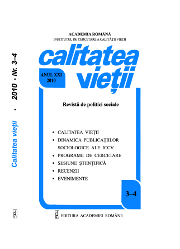Measurement Models of Life Satisfaction: A Structural Equation Modeling Approach
Measurement Models of Life Satisfaction: A Structural Equation Modeling Approach
Author(s): Bogdan Voicu, Cosmina-Elena PopSubject(s): Social Sciences
Published by: Editura Academiei Române
Keywords: life satisfaction; domain satisfactions; top-down; bottom-up; SEM models of life satisfaction
Summary/Abstract: Two types of indicators are usually employed for measuring life satisfaction at individual level. One of the options is to measure a general or overall life satisfaction (OVLS). Another option is to consider the satisfaction with various life facets or domains (DS). Top-down, bottom-up and integrated models may be imagined for describing the relations between the overall life satisfaction and the domain satisfactions. The top-down (TD) approach supposes that OvLS determines DS as an intermediate chain for more general personality characteristics which determines life satisfaction. The bottom-up (BU) explanation sees OvLS as a product of the objective life condition mediated through the DS. An integrated model (IM) searches to reconcile the two perspectives, simultaneously considering the TD and the BU dependencies. Our paper tests for empirical validation of the three approaches, using simultaneous equation modeling on the EQLS 2003 data. We show that BU, TD and IM find similar support within the data, but the IM seems to better fit empirical evidences. On the other hand, no matter the approach, each DS-OvLS relation remains significant, even when controlling the objective life conditions. We found support for conceiving each domain of satisfaction as part of a dense network of interrelations with all other DS. More than this, each DS is strongly embedded in a more general satisfaction that depends on the objective conditions.
Journal: Calitatea vieţii
- Issue Year: XXII/2011
- Issue No: 2
- Page Range: 137-154
- Page Count: 18
- Language: English

